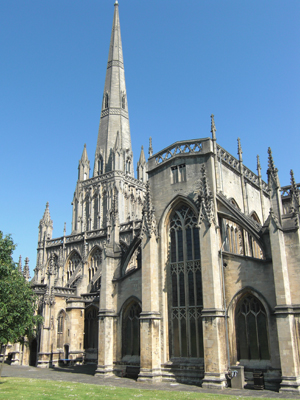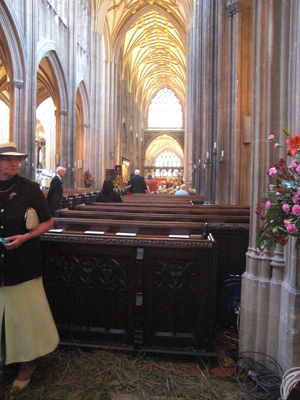| |
 |
 |
 |
| Comment on this report, or find other reports. |
 |
| Our Mystery Worshippers are volunteers who warm church pews for us around the world. If you'd like to become a Mystery Worshipper, start here. |
 |
| Find out how to reproduce this report in your church magazine or website. |
|
|
| 1748: St Mary
Redcliffe, Bristol, England |
 |
 |
 |
Mystery Worshipper:
Traveller.
The church:
St
Mary Redcliffe, Bristol, England.
Denomination:
Church of England, Diocese
of Bristol.
The building:
St Mary Redcliffe was described by Queen Elizabeth I in 1574
as "the fairest, goodliest and most famous parish church in
England," and who are we to disagree? There has been a church
on the site for over 800 years, but most of today's building
dates from the 15th century. The exterior is all soaring verticals
with an enormous spire, crockets, lacework tracery, flying buttresses
and huge windows. Much of the medieval decoration, such as the
rood screen, was lost during the Civil War and Commonwealth
after good Queen Bess' comment. However, there has been work
done on the building in every century following to add interest
to this place. The interior, with its vaulted roofs and painted
bosses (over a thousand of them, many of them gilded), is still
magnificent. The spire that is such a feature today was only
a stump for most of the building's life; it had collapsed in
1446 and was only replaced in 1872.
The church:
St Mary Redcliffe is the largest parish church in this major
UK city. It is only one kilometre from the cathedral, but maintains
links with the city and its life in a way that many other cities
would reserve for the cathedral. This may be because Bristol
and St Mary Redcliffe established links before Henry VIII created
the diocese of Bristol and made the former Augustinian abbey
its cathedral. The service we attended was an example of these
ancient links.
The neighbourhood:
St Mary Redcliffe stands beside what has become a busy roundabout
on the edge of the city centre close to Bristol's floating harbour
(a lock-sealed offshoot of the river Avon that provides an inland
port) in one direction, and the main railway station in the
other. The streets close by hold the Bristol General Hospital,
as well as some modern housing and office developments. The
commercial and retail heart of the city is but a short walk
away, but Bristol being an ancient place, one passes several
other churches en route.
The cast:
The Revd Dr Simon Taylor, priest in charge; the Revd Wendy Hough,
parish missioner and chaplain. There were also other clergy
whose names were not given. In attendance were the Rt Hon. Christopher
Davies, Lord Mayor of Bristol, as well as the city treasurer,
chief executive, and other dignitaries.
The date & time:
Pentecost Sunday, 31 May 2009, 11.00am.
What was the name of the service?
Choral Matins (Book of Common Prayer) for Rush Sunday 2009.
Rush Sunday, so called because arriving dignitaries tread over
a carpet of rushes on their way to their pews, dates from 1494.
William Spenser, Bristol's mayor who had died in 1493, had left
money in his will for sermons to be preached to the mayor and
commonalty each year at Whitsuntide. The date 2009 is significant
because this annual event is now in its 515th year.
How full was the building?
The event was ticket only, but there were a few places untaken
around us. The building is of generous proportions, so it still
meant that about 500 were present.
Did anyone welcome you personally?
There was a big throng at the door as we arrived, with several stewards around (all with red carnations in buttonholes, many in tailcoats) but we obviously looked too confident and interested in the building and the rushes on the floor to need assistance or special welcome.
Was your pew comfortable?
A formed wooden seat on a stackable metal frame. It proved surprisingly
comfortable, probably more so than the pews which lined the
centre aisle.
How would you describe the pre-service
atmosphere?
Busy. We arrived rather earlier than intended, but the place
was still buzzing when we got there. There was a choir practice
in progress, coordinating with the brass band. Friends were
greeting each other and chatting, stewards were showing people
to their (ticket-assigned) seats, the brass band played merrily
after the practice, and finally the organist took over to play
suitable soothing tones. It was fun watching on the video screen
in place for the day (see more below) as people arrived.
What were the exact opening words of the
service?
"Grace, mercy and peace from God our Father and the Lord
Jesus Christ be with you." (This followed a formal welcome
from the priest in charge to the assembled dignitaries, but
I don't count that as part of the service.)
What books did the congregation use during the
service?
A 19 page booklet specially produced for the occasion, of which
two pages were dedicated to the order of the processions in
and out. The booklet had all the words for the hymns and psalm,
creed, collects and prayers, plus information about the history
of the Rush service.
What musical instruments were played?
An electronic organ by the Makin company of Shaw, Lancashire,
was pressed into temporary service whilst St Mary's pipe organ
is undergoing restoration. There was also a brass quintet for
the day (two trumpets, French horn, trombone and tuba).

Did anything distract you?
The robes! The hats! This was the great and the good of Bristol
in all their finery. The councillors and aldermen were in long
red robes with black trimmings with black tricorne hats (removed
of course inside the building). The ladies in the church were
not to be outdone, and there were more hats in church than I
have seen in many a long year. As some of those were "fascinators,"
with bits bobbing around as the head moves, it was quite amusing,
not to say distracting.
Was the worship stiff-upper-lip,
happy clappy, or what?
Rather formal. The ceremony has changed little down through
the centuries. The dignitaries processed around the churchyard
in their scarlet robes and then across the carpet of rushes
to their pews. The service itself was very challenging musically:
Bernard Rose's Preces and Responses were wonderful;
the Jubilate was Herbert Howells' Collegium Regale
setting; the anthem was a modern (i.e., dissonant) version of
"Come Holy Ghost" by Andrew Carter. All that, plus four hymns,
the psalm, and the National Anthem in conclusion.
Exactly how long was the
sermon?
12 minutes.
On a scale of 1-10, how good was the preacher?
9 – The priest in charge spoke clearly in tone and idea
and made good points for his listeners without being condescending
or too technical. He spoke from notes, but his delivery was
fluent.
In a nutshell, what was the sermon
about?
He began with a joke and then went on to use it as an illustration
of "The Big Sort," a concept by Bill Bishop, an American
author, that we increasingly tend to live, work, socialise and
worship with people who think like we do. But differences are
important. In the first lesson (Gen. 11:1-9, the tower of Babel),
we see that God confused man's language so that all men would
not be the same. In the second lesson (Acts 2:1-11, the coming
of the Holy Spirit and the speaking in tongues), we see that
everyone remained different even though they could all understand
what was being preached. Our differences are God's gift to us.
We should enjoy them, whilst learning to live and work together.
Pentecost brings us together, but keeps us distinct.
Which part of the service was like being in
heaven?
The choral music (yes, I am a singer, so that is no surprise).
Here is a parish church (a special one, but still a parish church)
that is within a mile of a cathedral, that manages to maintain
a boys-only top line choir that sings some very demanding music.
And which part was like being in... er... the other place?
There were several large video screens positioned in the side
aisles so that all could see what was going on outside before
as well as inside during the service. Unfortunately, there was
a quarter second delay in the video signal, so you heard the
words, then saw the speaker's mouth move. When the camera was
on the choirmaster, he was behind the beat! I had consciously
to not watch the screens during the sermon, as it got so irritating.
What happened when you hung around after the service looking lost?
Most people didn't stay to listen to the organ voluntary, but
headed for the south door. Everyone looked fairly lost. As has
been the custom since the first Rush Sunday 515 years ago, all
of the dignitaries received a nosegay before processing out.
How would you describe
the after-service coffee?
This, too, has changed little since 1494 – some traditions
are very good! William Spenser had provided in his will for
the Lord Mayor to serve sherry and cakes to the congregation.
Tables were set up in the bright sunshine in the churchyard,
well stocked with sherry, orange juice and wine. I don't believe
coffee was available, though.
How would you feel about
making this church your regular (where 10 = ecstatic, 0 = terminal)?
8 – Not easy to judge from this exceptional occasion, but the ceremonial and music seemed to fit our comfort zone.
Did the service make you feel glad to be a
Christian?
Yes. Bristol is one of the major cities in the UK, and to see
an ancient church-going and preaching custom maintained and
a thought-provoking and challenging sermon delivered is encouraging.
What one thing will you remember about all this in seven days' time?
The smell! The rushes on the floor and the flowers in nosegays
for the ceremonial guests made an overwhelming scent as we entered
the church. One got used to it during the service, but we noticed
it again when leaving. |
|
|
 |
 |
 |
| We rely on voluntary donations to stay online. If you're a regular visitor to Ship of Fools, please consider supporting us. |
 |
 |
 |
| The Mystery Pilgrim |
 |
| One of our most seasoned reporters makes the Camino pilgrimage to Santiago de Compostela in Spain. Read here. |
 |
 |
 |
| London churches |
 |
| Read reports from 70 London churches, visited by a small army of Mystery Worshippers on one single Sunday. Read here. |
| |
|
|
|
|


